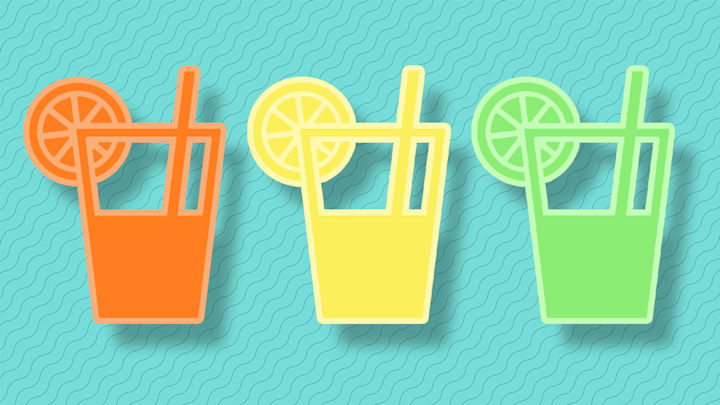Lemonade, limeade, Gatorade—even Kool-Aid, despite its spelling. Thanks to these and other beverages, we recognize -ade as shorthand for “fruit-flavored drink.” But the suffix itself has nothing to do with fruit or drinks.
What’s in an Ade?
Sources generally credit lemonade as the beverage behind the trend. The term, which came from the French limonade, was in print by the mid-17th century. “Captain, make some Lemonade,” one character says in Thomas Killigrew’s play The Parson’s Wedding, first performed around 1640 and published in 1664. Lemonado, a variant based on the Spanish limonada, also cropped up in 17th-century English plays.
The suffix -ade and other versions—like Spanish’s -ada/o and Italian’s -ata/o—derive from the Latin past participle endings -ata (feminine) and -atus (masculine). They serve too many purposes to summarize in one definition. But sometimes, they denote the product of an action: A frittata, for example, is something fried (fritto is Italian for “fried”). They can also more loosely refer to something that features whatever the root word is. That’s the case with lemonade, which basically just means “something involving lemons.”

Nouns like these often take on more specific meanings than their word parts suggest. A frittata isn’t just anything fried—it’s an egg-based dish (that plenty of people bake rather than fry). And lemonade isn’t just anything involving lemons—it’s a beverage made with lemon juice, sugar, and water.
In short, there’s nothing drink-specific about -ade. It’s a testament to lemonade’s success that people co-opted the suffix for other sweetened fruit drinks. Europeans embraced lemonade in full force during the 1600s (though Egyptians had enjoyed lemon-based beverages centuries earlier), and it didn’t take long for the first -ade offshoot to appear: Orengade (a.k.a. orangeade) hit print in 1672. By the late 19th century, raspberryade, cherryade, and limeade had joined it.
How Gatorade, Lucozade, and Kool-Aid Got Their Names
In the 20th century, the convention went commercial. The British energy drink Lucozade is named after glucose, the simple sugar it contains. Its original name reportedly was Glucozade, though it’s not clear exactly when it was changed—certainly by the mid-1930s, when the product landed in newspaper ads. “When Doctors and Nurses are fighting to restore an exhausted patient to health, they put him on LUCOZADE—a tonic drink rich in … pure medicinal Glucose. For Glucose is energy,” one 1939 advertisement said.
Kool-Aid started out with a different name, too: Kool-Ade, trademarked by Nebraska-based inventor Edwin Perkins in 1928. As the story goes, Perkins changed the spelling either due to pressure from a competitor or because officials took issue with -ade being used for a product that didn’t contain fruit juice. The truth is foggy, but it’s worth noting that the FDA did regulate the label during this era. In the mid-1930s, shipments of Kold-Ade—a line of fruity drinks from Brooklyn’s Drew Corporation—were confiscated for alleged misbranding. The drink labels, as a Pennsylvania district court put it, “tended to deceive and mislead the purchaser when applied to products that contained artificial color and little or no fruit juice.”
Ironically, Gatorade chose -ade to avoid the FDA’s rules for using aid. “We were told that you couldn’t use [aid] because the FDA prohibited that,” Gatorade co-creator Dana L. Shires Jr. said in a 2001 interview. “That would classify it as something other than a cola or soft drink, so we changed it to -ade.” Gator is a nod to the Florida Gators, the University of Florida football team that Gatorade was invented for in the 1960s.
These days, the FDA has strict requirements for calling products “juice,” but nothing in particular for “ade.” The term is only mentioned as one of many items made from “fresh fruits and fruit juices” or “processed fruits and fruit juices.” And despite its strong association with beverages, -ade isn’t exclusive to them. Take Urinal-Ade, a deodorizing drain cover that refreshes in a different way.
Explore More Language Stories:
